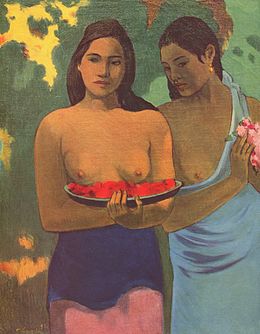Shipping from Europe with tracking number / Paris mint
Breasts with red flowers
| Artist | Paul Gauguin |
|---|---|
| Date | 1899 |
| Kind | Genre scene _ _ |
| Technical | Oil on canvas |
| place of creation | |
| Dimensions (H × W) | 94×72.4cm |
| Inventory number _ | 49.58.1 |
| Location | Metropolitan Museum of Art |
Breasts with Red Flowers ,also called Two Tahitian Women or Women with Mangos , is an oil on canvas by Paul Gauguin painted in 1899 and kept at the Metropolitan Museum of Art , New York . 94 centimeters high and 72.4 wide; it represents two bare-breasted Tahitian women , one of whom carries a tray of red flowers .
Paul Gauguin
Paul Gauguin | |
|---|---|
 Gauguin in 1891 | |
| Born | Eugène Henri Paul Gauguin 7 June 1848 Paris, French Second Republic |
| Died | 8 May 1903 (aged 54) |
| Known for | Painting, sculpture, ceramics, engraving |
| Movement | Post-Impressionism, Primitivism, Synthetism |
| Spouse(s) | Mette-Sophie Gad (m. 1873; separated 1894) |
Eugène Henri Paul Gauguin (UK: /ˈɡoʊɡæ̃/, US: /ɡoʊˈɡæ̃/; French: [ø.ʒɛn ɑ̃.ʁi pɔl ɡo.ɡɛ̃]; 7 June 1848 – 8 May 1903) was a French Post-Impressionist artist. Unappreciated until after his death, Gauguin is now recognized for his experimental use of color and Synthetist style that were distinct from Impressionism. Toward the end of his life, he spent ten years in French Polynesia. The paintings from this time depict people or landscapes from that region.
His work was influential on the French avant-garde and many modern artists, such as Pablo Picasso and Henri Matisse, and he is well known for his relationship with Vincent and Theo van Gogh. Gauguin's art became popular after his death, partially from the efforts of dealer Ambroise Vollard, who organized exhibitions of his work late in his career and assisted in organizing two important posthumous exhibitions in Paris.[1][2]
Gauguin was an important figure in the Symbolist movement as a painter, sculptor, printmaker, ceramist, and writer. His expression of the inherent meaning of the subjects in his paintings, under the influence of the cloisonnist style, paved the way for Primitivism and the return to the pastoral. He was also an influential practitioner of wood engraving and woodcuts as art forms
